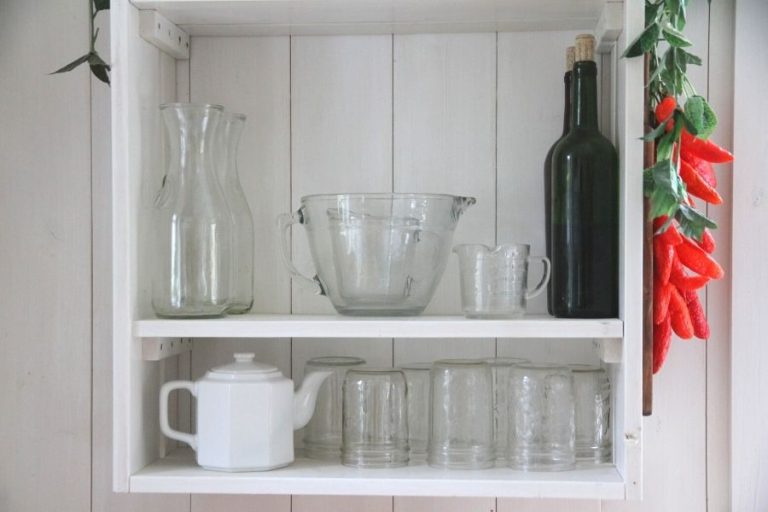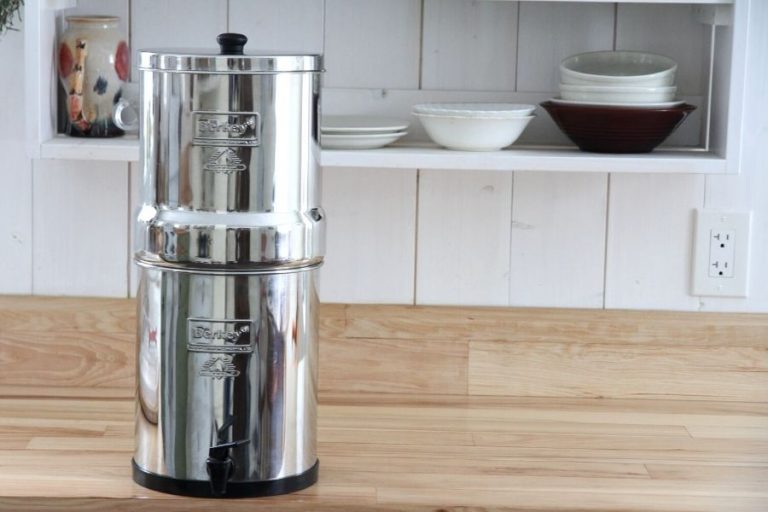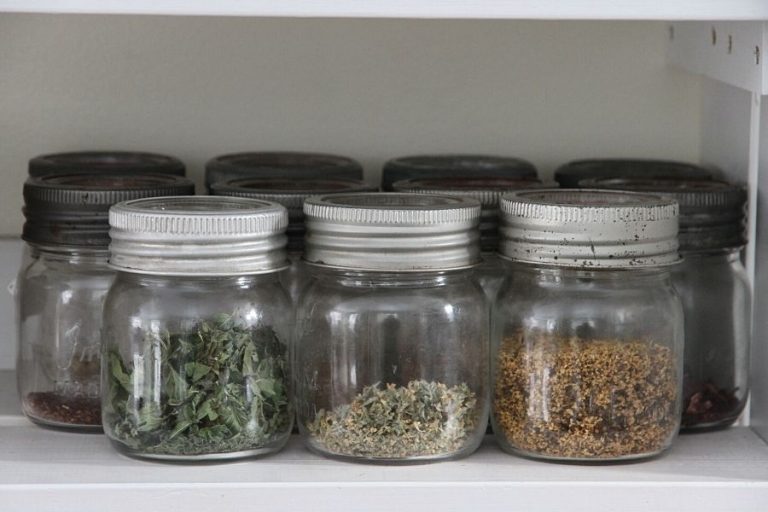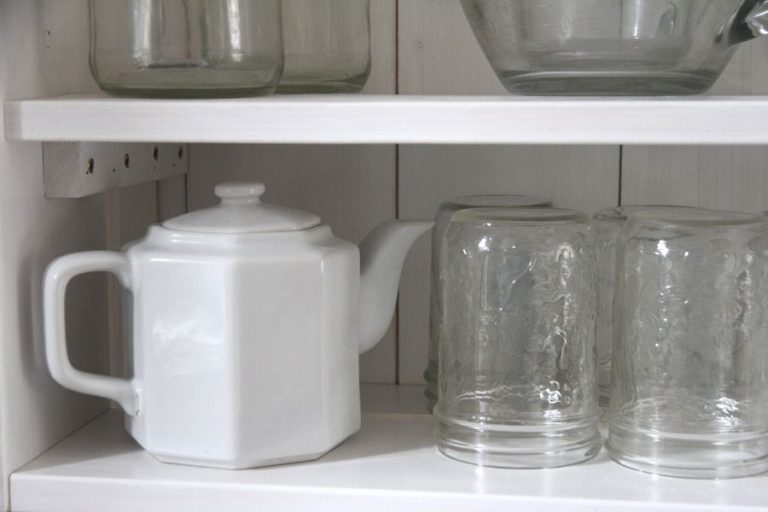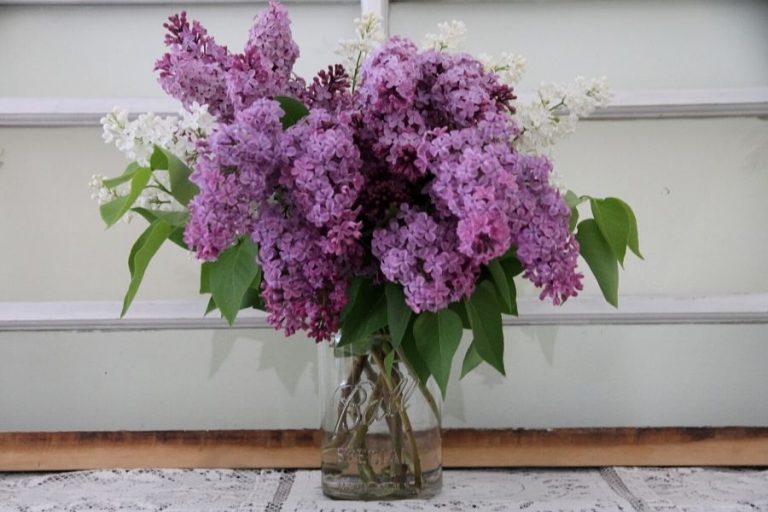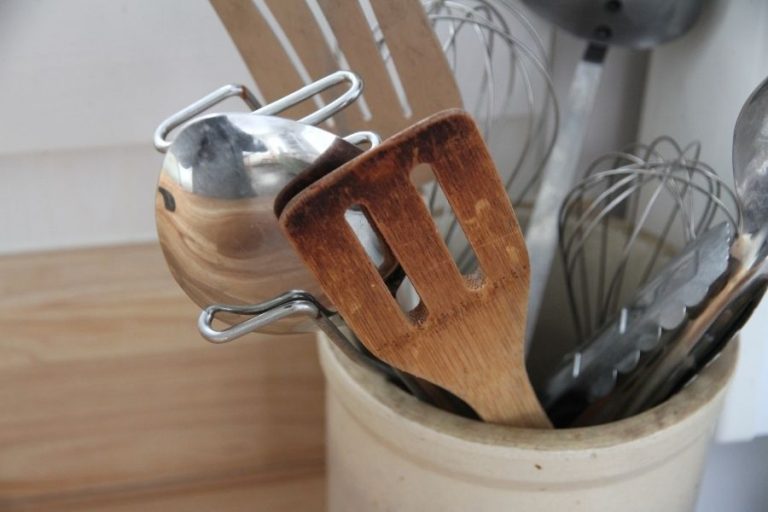4 Simple Ways to Use Dried Herbs in Kitchen Decor
Bring some country charm to your kitchen by learning how to used dried herbs in your kitchen decor!
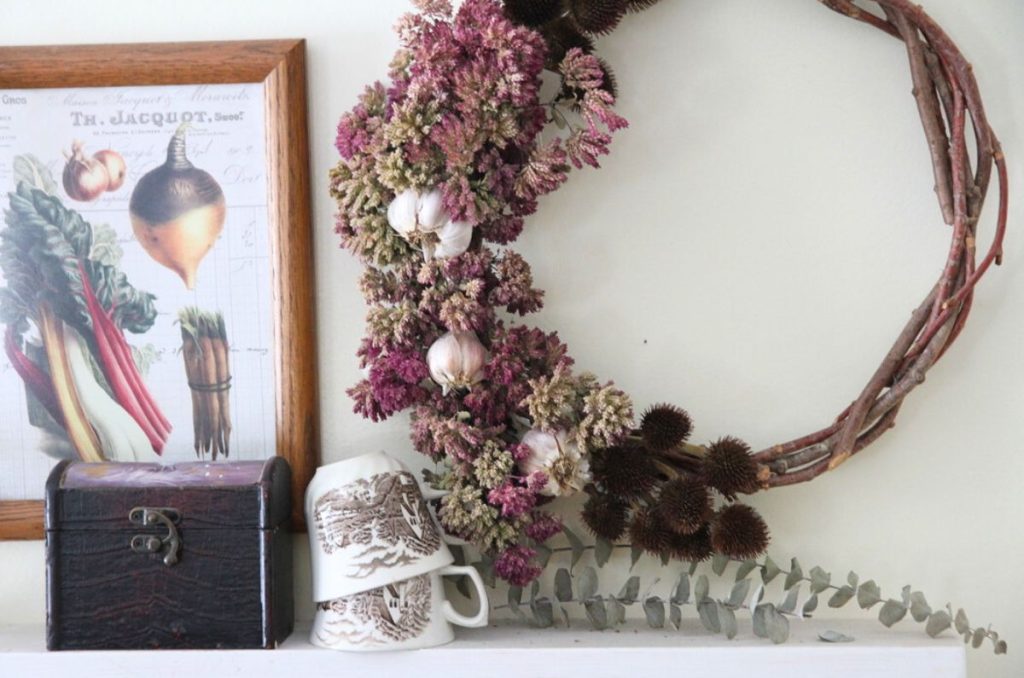
Every year, I grow fresh herbs in my little kitchen garden. Some are annuals (like fresh basil) and others are perennial herbs that come back year after year.
I like growing vegetables in my primary garden, but I especially enjoy kitchen gardening, and am always on the lookout for new herbs to try. Especially if they're perennials in my growing zone!
Home grown herbs serve several purposes in my kitchen. Some are used for home remedies, others are for tea and still others are primarily used in my home cooking.
Over the years, I've discovered that dry herbs aren't just useful. They also make beautiful cottage kitchen decor!
When I first began drying my own herbs, I used an electric dehydrator.
But these days, I'm really into air drying them instead. It's low maintenance, and you can do a lot all at once. Plus, air dried herbs give you opportunity to do special things with your kitchen decor!
Don't get me wrong. Dried flowers have their place in the country kitchen.
But there is a wide variety of herbs that have lovely dried foliage, and even little flower or seed heads that add unique charm to your space.
Tip for the day: did you know a rose is a herb? The petals and rose hips both bring something unique to the table...and your country kitchen decor!
Overview: 4 Ways to Decorate with Herbs
There are 4 basic ways you can use dried herbs in your kitchen decor.
- Make dried "flower bouquet" arrangements.
- Create a herb wreath with fresh herbs and dry for wall art.
- Bundle fresh herbs and hang upside down to dry for a simple display.
- Store dried herbs in a clear glass container on an open shelf.
Want to learn more about decorating open shelves in the kitchen? You can read my article: Practical Ways to Style Open Kitchen Shelves (clutter free)
1. How to Make a Dried Flower Bouquet
When choosing herbs for bouquet arrangements, you must use varieties that are tough enough to withstand handling after they've been dried.
Here are some of my best tips that will help you choose the right herbs for floral arrangements. I even give you a few ideas for herb types themselves!

Characteristics You Need in Herbs
- Plants with a strong center stem that won't easily break when handled.
- Foliage that won't curl up and disappear when dry (hint: oregano leaves are terrible for this!).
- Leaflets that won't easily fall away from the main stem.
- Leaves or blossoms that are tough when dry and won't crumble when handled.
Best herbs for floral arrangements
These herbs can be great in floral arrangements.
- Bee balm
- Dill heads
- Lavender (foliage or flower stems)
- Hyssop flower heads
- Oregano flowering heads
- Tarragon
- Thyme
- Roses (domestic)
- Rosemary
How to Dry Flowers for Bouquets
You don't want to use a dehydrator to dry herbs for floral arrangements. Instead, it's best to dry them upside down in bundles, so the herb dries in natural form.
Here's how you do it.
- Harvest herbs or herb flowers while foliage is still in good condition.
- Bring fresh herbs indoors to the dining table, and separate them into bundles that fit in one hand.
- Tie the stem ends with a piece of twine or string.
- Hang your bundles upside down on a herb rack or a row of wall hooks.
- Leave herbs to dry for 3-4 weeks in a place where they have good air circulation.
- When the center stem is stiff and dry, herbs are ready to be used in a dried floral arrangement.
- Gently mix, match and have fun making a dry herb bouquet!
Helpful tip: don't be afraid to add in some dried flower or grasses for additional color and texture.
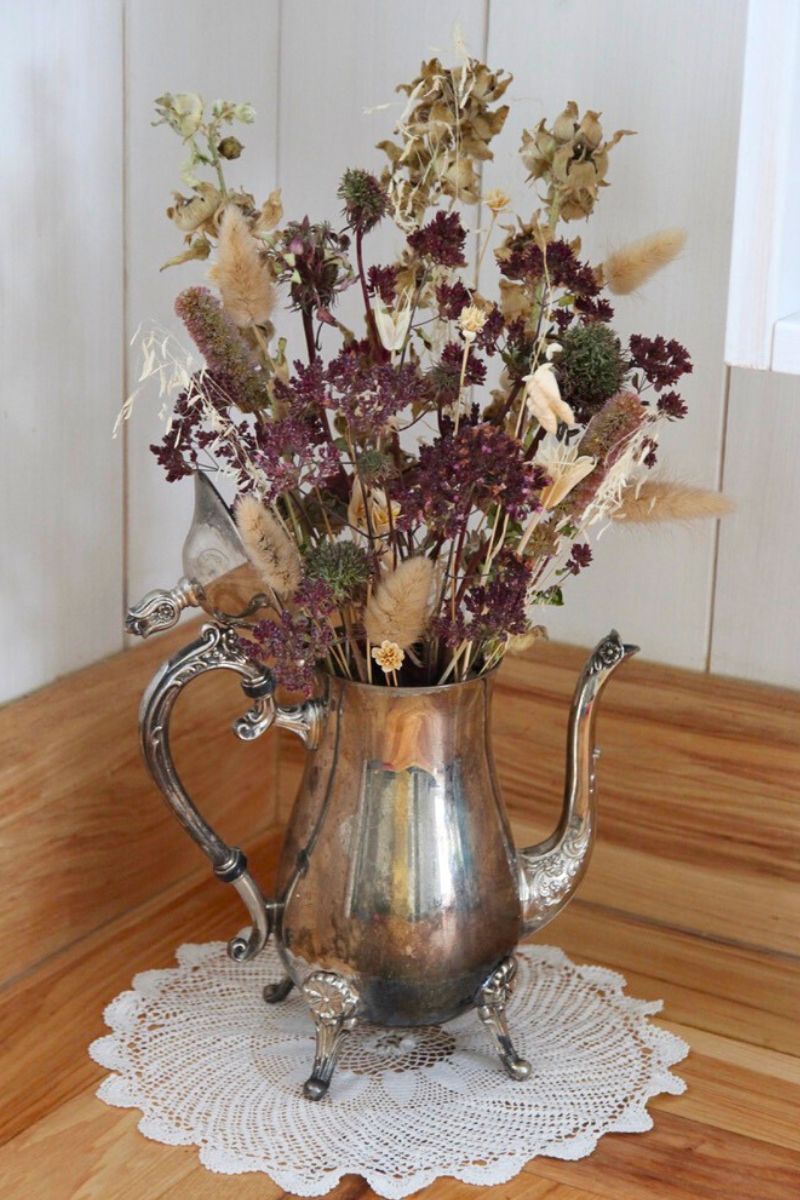
Where to Display Herb Bouquets in Your Kitchen
You can display your dried floral arrangement wherever you like to keep fresh flowers.
Here are a few suggestions.
- Kitchen table
- Window sill
- Corner of your counters
- An island
- Open kitchen shelves
- On top of a china cabinet
2. DIY Herb Wreath for Your Kitchen
Dry herb wreaths are lovely in the kitchen, or even in the dining room. If you have lots of herbs on hand, this is a unique and lovely project anyone can do.
You don't have to buy anything to make a kitchen wreath (I'll show you how to make a wreath frame and fill it), and you'll be using all natural materials.
It's a fun way to use an overabundance of herbs from the garden and especially, the flowering seed heads herbs put up in the summer.

Characteristics to Look For
Unlike herb bouquets, it's easiest to make wreaths with fresh herbs. Because of this, you need to use plants with woody, stiff stems that won't wilt or flop during the drying process.
Wreaths are hung vertically on the wall to dry, and whatever you use to adorn your frame has to stay in place.
Best Herbs for a Kitchen Wreath
Here's a list of good options to get you started!
- Dill seed heads
- Echinacea cones (I like to remove the flower petals
- Lavender
- Oregano flower heads
- Thyme
- Rose hips
- Rosemary
Sometimes herbs can fool you.
For example? You would think fresh oregano and sage would look lovely on a herb wreath. But both of these herbs will droop terribly when you hang your wreath to dry!
I tried making a fresh sage wreath one year and hung it on the dining room wall. The leaves drooped something terrible, but I didn't bother changing them out.
A friend and her little boy came to visit me a few weeks before Christmas, and while we were eating lunch, he noticed my drooping wreath.
Pointing at it, he said "look mama, a Grinch wreath!"
Ha ha!
After that, I stuck to herbs with tough stems and leaves that would dry in place, without drooping!
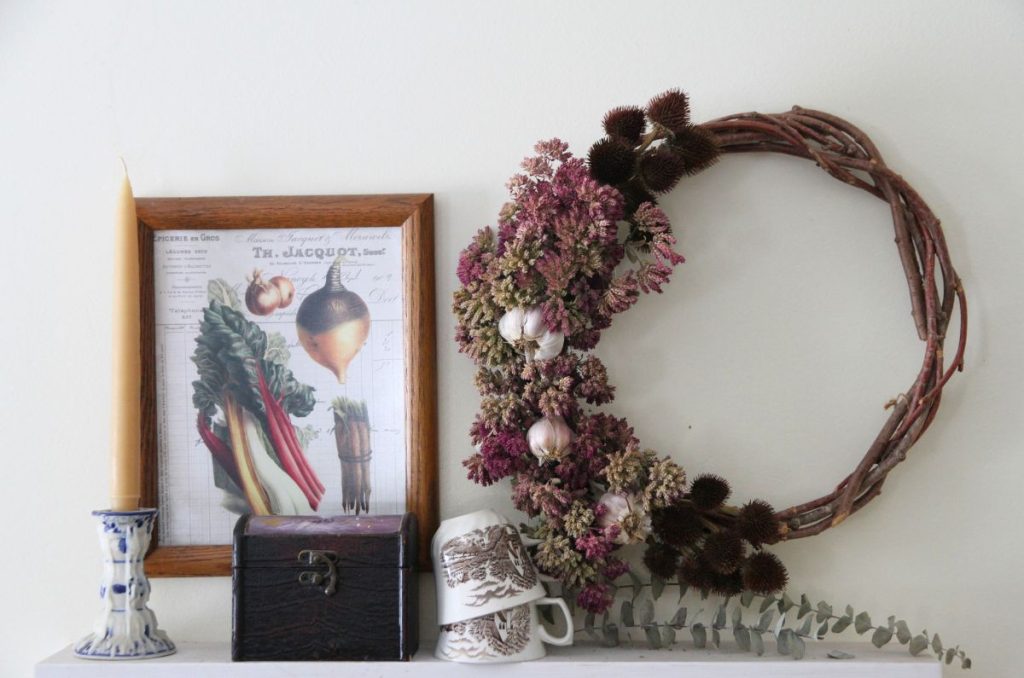
How to Make a Herb Wreath
You can make a herb wreath with one type of herb (like a rosemary wreath, for example), or you can mix and match. I also want to point out that if you have a nice wreath frame, you can save on the herbs and only fill part of it.
I teach you how to make a pretty, natural wreath frame here: How to Make a Wreath Out of Tree Branches
And you can learn how to make a herb wreath here: How to Make a Kitchen Wreath with Fresh Herbs
It usually takes herb wreaths 3-4 weeks to fully dry. After that, they can be kept just about anywhere!
Where to Display a Herb Wreath
- On a kitchen wall
- Above the kitchen stove
- Behind dishes or bowls on open kitchen shelving
- Hang it in a kitchen window
Important Note: I don't recommend hanging a dry herb wreath on a household or even a cupboard door. The constant jolting will cause the wreath to drop its foliage and will leave you with a mess on your hands!
3. How to Make a Dry Herb Bundle or Swag
One of the simplest ways to decorate your kitchen with different herbs is to create bundles or swags. This is my preferred method, because you can use nearly any type of herb!
These bundles are easy to form and hang upside down from a hook or nail in the kitchen wall.
Herbs will air dry of their own accord. Once dry, they hold their foliage and continue to act as part of your kitchen decor.

They're one of my favorite things to display in my cottage kitchen!
Best Herbs for Bundling
You can bundle just about any type of herb. But even still, the ones that will last the longest and look the fullest are listed below.
- Bee balm
- Dill heads
- Echinacea
- Lavender
- Oregano
- Sage
- Savory
- Tarragon
- Thyme
- Rosemary
How to Bundle and Dry Fresh Herbs
- Harvest handfuls of fresh herbs and stack them in a basket.
- Bring the harvest indoors to a kitchen or dining table.
- Divide herbs into bundles that will fit in one hand.
- Tie the stems of your herbs with a piece of twine or cotton cooking string (note: don't use rubber bands; they're hard to get on and off).
- Hang bundles from hooks or nails in the kitchen wall. You can also use a herb drying rack.
- Leave herbs to dry where there is good air circulation.
The drying process will take several weeks to complete, especially for herbs with larger leaves (like sage).
Feel free to check out my other tutorials below!
How to Make Herb Swag for Your Kitchen
Easy Way to Dry Sage in Bundles

How to Decorate with Herb Bundles
Herb bundles are a great way to add a subtle touch of earthy, country charm to your kitchen. Here are my favorite places to display herb swags.
- From a row of nails on the wall.
- A hanging herb rack
- On hooks fastened under a wall shelf
- The side of a kitchen cabinet or shelf
- Above the cooking stove
4. How to Decorate with Herb Jars
Dried herbs are wonderful for making dried flower arrangements.
You can create homemade wreaths with fresh herbs and let the foliage dry, for a year-round kitchen display.
Bundling is another lovely way to display herbs in the kitchen.
But there's still another method that adds quiet charm to the kitchen: herbs look lovely when displayed in glass mason jars.
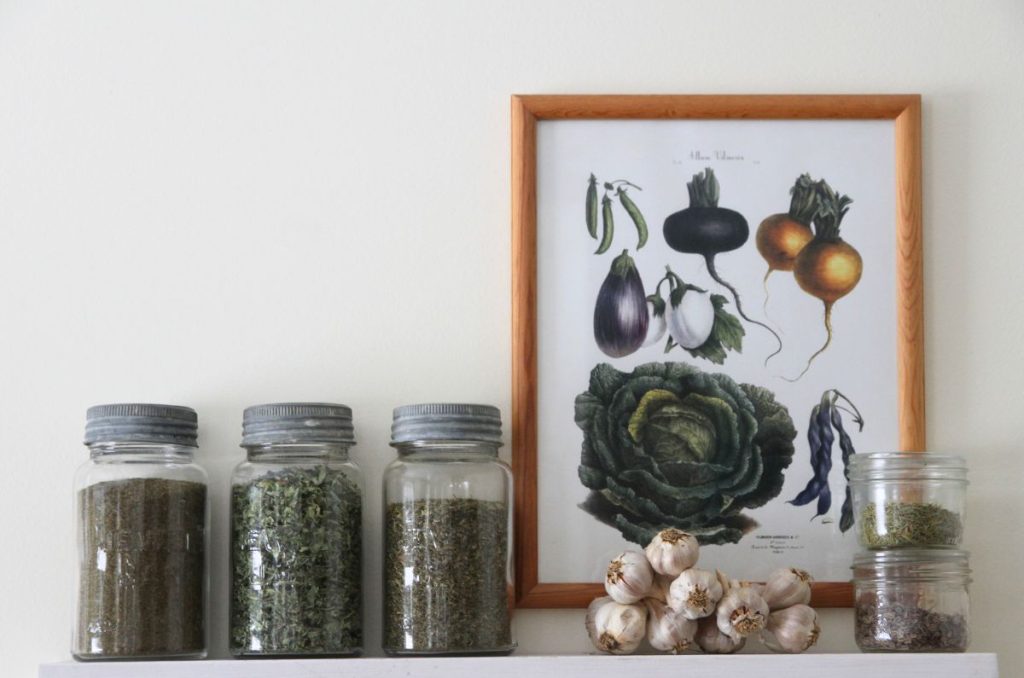
This method is a great options for tender herbs that crumble to the touch.
If your herbs are too fragile for bouquets, wreath making or bundling...just jar them instead!
Best Herbs for Glass Jars
Here's a list of fragile herbs you could consider.
- Basil
- Calendula
- Catnip
- Chamomile
- Dill leaflets
- Echinacea
- Lemon Balm
- Oregano leaves
- Parsley
- Peppermint
- Raspberry leaves
- Rose petals
- Spearmint
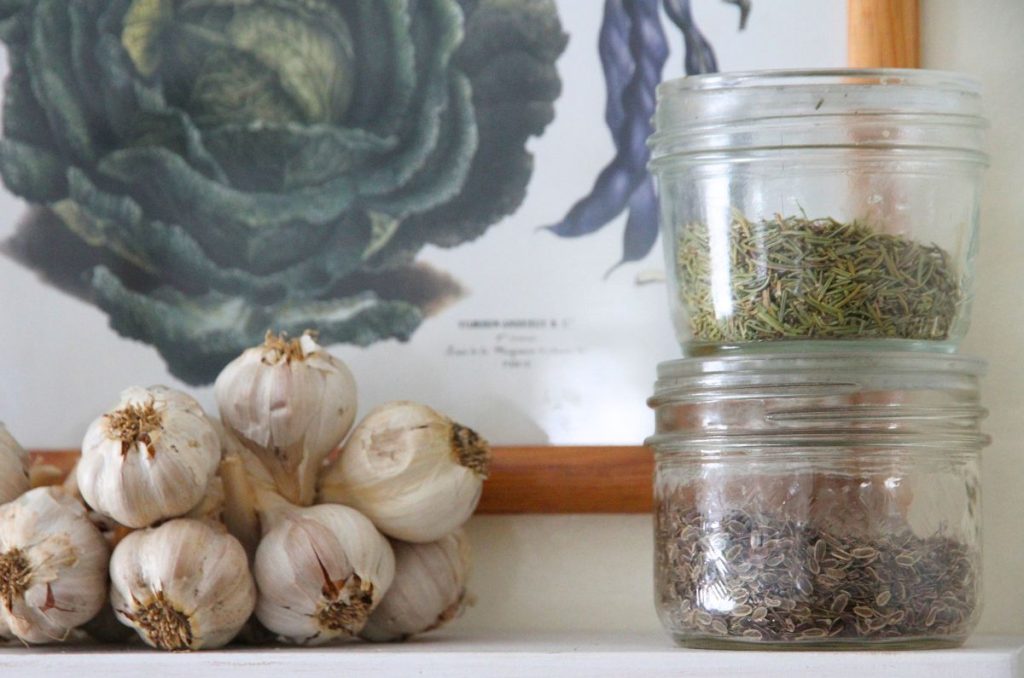
How to Air Dry Fresh Herbs for Container Storage
There are a few different ways to dry herbs for jar storage. The main thing is to be sure your herbs are 100% dry, or they might mold in an airtight container.
Here are some ways to effectively dry herbs at home.
- Place herbs that grow sparsely on the stem (like thyme) in a large basket and fluff them up, so they get good airflow.
- Let them sit for 4-5 weeks to air dry before removing the tiny leaves.
- Use an electric dehydrator: this is helpful if you have herbs with juicy stems (like fresh basil), because it speeds the drying process.
- The car: if you have a hot summer day, close the windows of your car, spread herbs out on a towel and let the natural heat dry them out for a few days.
- Bundle your herbs and hang in a dry place, until leaves are dry and crumble when squeezed in your hand.
Important note: when air drying herbs, the leafstalk (stem running through your leaf) will be the last to dry out. If this is dry, you know everything is dry!
With all herbs, you should strip leaves from the stems before stuffing your glass jars. Pop an old canning lid into place, and you're done!
Here are a few other herb drying tutorials I wrote for you!
How to Dry Thyme Sprigs in Bulk
Growing and Drying Mint Leaves for Tea
How to Dehydrate and Make Celery Leaf Powder
How to Decorate with Jars of Herbs
You can display jars of home dried herbs wherever you please!
- On the kitchen counter
- Open kitchen shelving
- Kitchen island
- At the back of your kitchen stove
- In a wicker basket by the stove
- A spice rack
When it's all said and done, there are endless ways to use the subtle charm of dried herbs in your kitchen.
I think it's great that we can use natural materials from the garden to decorate our spaces. And it's a fun way to make something that is unique to your own kitchen.
